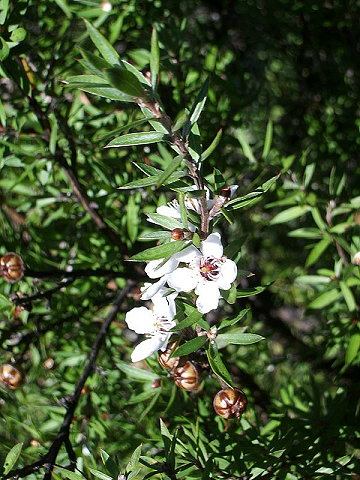
|
|
Manuka (Leptospermum scoparium). Flowers and
fruits.
|
Manuka - New Zealand Tea Tree - Leptospermum scoparium
Leptospermum scoparium, commonly called manuka, manuka myrtle, New Zealand teatree, broom tea-tree, or just tea tree, is a species of flowering plant in the myrtle family Myrtaceae, native to Australia and New
Zealand.
It is a prolific scrub-type tree and is often one of the first species to regenerate on cleared land. It is typically a shrub growing to 2–5 m (7–16 ft) tall, but can grow into a moderately sized tree, up to 15 m (49 ft) or so in height. It is evergreen, with dense branching and small leaves 7–20 mm long and 2–6 mm broad, with a short spine
tip. The leaves have a nice, sharp perfume when
crushed. The brownish bark sits loosely on the trunk and branches in long
strips. The flowers are white, occasionally pink, 8–15 mm (rarely up to 25 mm) in diameter, with five
petals, which generally bloom in spring and summer.The flowers are hermaphrodite
(have both male and female organs) and are pollinated by Insects.
The seed capsules are brown and woody – the seed ripens by late
autumn, but stays in the hard capsules until well into the following summer. The very light seed of manuka is produced in abundance and is wind
dispersed.Sow the seed when fresh and keep in intermediate conditions ie no more than 20oC and they should germinate within 10
days.
This species is often confused with the closely related species kanuka (Kunzea ericoides)– the easiest way to tell the difference between the two species in the field is to feel their foliage – manuka leaves are prickly, while kanuka leaves are soft. The wood is tough and
hard. The manuka plant is related to the Australian ‘tea
tree’ (Melaleuca alternifolia) and both have many medicinal uses.
Evidence suggests that L. scoparium originated in Australia before the onset of the Miocene aridity, and dispersed relatively recently from eastern Australia to New Zealand. It has been postulated that on arrival in New Zealand, L. scoparium became established in limited edaphically suitable areas until the arrival of the Polynesian people, whose fire and forest-clearing brought about the low-nutrient-status soils for which it was preadapted in its homeland. It is now found throughout New Zealand, but is particularly common on the drier east coasts of the North and South Islands, and in Australia in Tasmania, Victoria and New South
Wales. It can be found in many different habitats (places to
live) including wetlands, river gravels and dry hillsides. When mature, it is very tolerant of
drought, waterlogging, strong winds and frost.
Manuka (from Maori) is the common name used. "Jelly bush" and "tea tree" are also used in Australia and to a lesser extent in New Zealand. This name arose because Captain Cook and early settlers used the green leaves to make a reasonable substitute for tea
(and beer)
The fresh, pungent leaves are a fragrant and refreshing tea
substitute]. Of excellent quality, in taste trials this species has often received higher marks than the traditional China tea obtained from Camellia
sinensis. It is important to brew the leaves for considerably longer than normal teas to ensure the flavour is released into the
water. Although it would be safe to say that
flavour isn’t one of manuka tea’s strong points! Manuka sawdust, however, is
used for smoking fish and meats to impart a delicious flavour. A sweet manna is sometimes exuded from the stems as a result of insect
damage. Another report says that manna is reported to form on the leaves.
Manuka’s hard red wood was widely used by Maori for everything from
paddles, weapons, spade blades, weeders, bird spears and mauls to house building. The bark was used for making water containers and the inner bark as a waterproof layer for
roofing. Manuka is a first class firewood and was also used by early settlers for tool handles and
fencing.
Manuka is cultivated in New Zealand for manuka honey, produced when honeybees gather the nectar from its
flowers, and for the pharmaceutical industry. IManuka honey is highly prized not only for its distinctive strong taste but it has been shown to have extraordinary
anti-bacterial and anti-fungal properties. It is often used topically to help heal
boils, burns, cuts and even acne as well as soothe sore throats when taken either by the spoonful or in freshly brewed
lemon, manuka honey and ginger tea.
It is also used for producing essential oils by steam distillation of its
leaves. Manuka Essential Oil is modernly used widely as a potent natural anti-fungal and antibacterial
agent. Produced mostly on East Cape, and is sold in New Zealand and many other
countries.
Source:
https://en.wikipedia.org/wiki/Leptospermum_scoparium
http://www.pfaf.org/user/Plant.aspx?LatinName=Leptospermum+scoparium
http://www.tfsnz.org.nz/uncategorized/tea-tree/
http://activeadventures.com/new-zealand/about/nature/flora/manuka-tree
